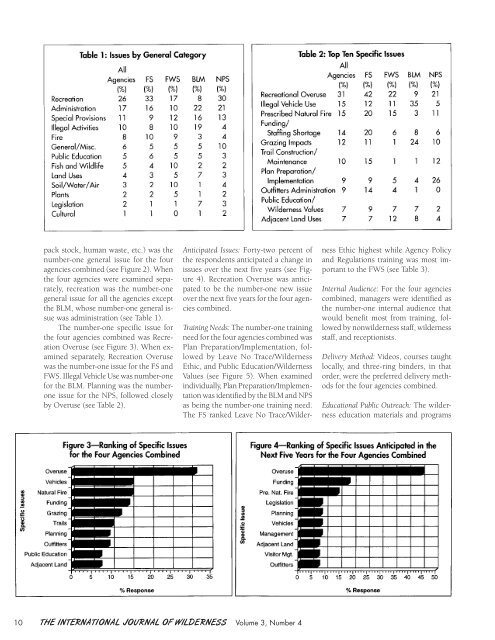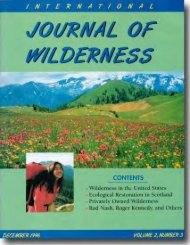Download full PDF - International Journal of Wilderness
Download full PDF - International Journal of Wilderness
Download full PDF - International Journal of Wilderness
You also want an ePaper? Increase the reach of your titles
YUMPU automatically turns print PDFs into web optimized ePapers that Google loves.
pack stock, human waste, etc.) was the<br />
number-one general issue for the four<br />
agencies combined (see Figure 2). When<br />
the four agencies were examined separately,<br />
recreation was the number-one<br />
general issue for all the agencies except<br />
the BLM, whose number-one general issue<br />
was administration (see Table 1).<br />
The number-one specific issue for<br />
the four agencies combined was Recreation<br />
Overuse (see Figure 3). When examined<br />
separately, Recreation Overuse<br />
was the number-one issue for the FS and<br />
FWS. Illegal Vehicle Use was number-one<br />
for the BLM. Planning was the numberone<br />
issue for the NPS, followed closely<br />
by Overuse (see Table 2).<br />
Anticipated Issues: Forty-two percent <strong>of</strong><br />
the respondents anticipated a change in<br />
issues over the next five years (see Figure<br />
4). Recreation Overuse was anticipated<br />
to be the number-one new issue<br />
over the next five years for the four agencies<br />
combined.<br />
Training Needs: The number-one training<br />
need for the four agencies combined was<br />
Plan Preparation/Implementation, followed<br />
by Leave No Trace/<strong>Wilderness</strong><br />
Ethic, and Public Education/<strong>Wilderness</strong><br />
Values (see Figure 5). When examined<br />
individually, Plan Preparation/Implementation<br />
was identified by the BLM and NPS<br />
as being the number-one training need.<br />
The FS ranked Leave No Trace/Wilder-<br />
10 THE INTERNATIONAL JOURNAL OF WILDERNESS Volume 3, Number 4<br />
ness Ethic highest while Agency Policy<br />
and Regulations training was most important<br />
to the FWS (see Table 3).<br />
Internal Audience: For the four agencies<br />
combined, managers were identified as<br />
the number-one internal audience that<br />
would benefit most from training, followed<br />
by nonwilderness staff, wilderness<br />
staff, and receptionists.<br />
Delivery Method: Videos, courses taught<br />
locally, and three-ring binders, in that<br />
order, were the preferred delivery methods<br />
for the four agencies combined.<br />
Educational Public Outreach: The wilderness<br />
education materials and programs










